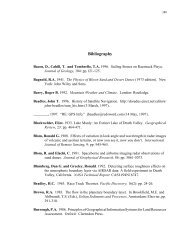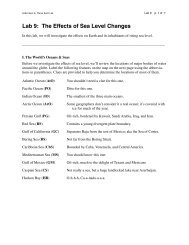Lab 1: Space Science
Lab 1: Space Science
Lab 1: Space Science
You also want an ePaper? Increase the reach of your titles
YUMPU automatically turns print PDFs into web optimized ePapers that Google loves.
SJSU Geol 4L Planet Earth <strong>Lab</strong> <strong>Lab</strong> 1 p.1 of 10<br />
<strong>Lab</strong> 1: <strong>Space</strong> <strong>Science</strong><br />
The goals of this space-oriented lab:<br />
(1) Use spectroscopes to identify the elements in various light sources.<br />
(2) Indirectly calculate the distance to an object outside or in the classroom in order to model<br />
how astronomers calculate the distance to an object in space.<br />
_____________________________________________________________________________<br />
I. Spectroscopy<br />
A. The electromagnetic spectrum: A quick review<br />
Stars such as the Sun produce radiation over a range of wavelengths. We see visible light in a<br />
narrow range of this spectrum, as shown on Plate 1.<br />
1. Does red light or blue light have a shorter wavelength? ___________<br />
2. Do radio waves or microwaves have a shorter wavelength? __________________<br />
3. Which has a shorter wavelength: ultraviolet radiation or infrared radiation? (circle one)<br />
Scientists use the full electromagnetic spectrum to learn more about the Sun, stars, and universe.<br />
For example, radio waves help them understand magnetic fields in space, and ultraviolet waves<br />
help them study hot gases that aren’t apparent in visible light. The most accurate information is<br />
collected by satellites (e.g, the Hubble <strong>Space</strong> Telescope) that lie above the interfering effects of<br />
Earth’s atmosphere.<br />
Astronomical studies also frequently use visible light, and that’s what we’ll focus on in this lab.<br />
We’ll use spectroscopes to identify chemical elements in various light sources. Each element radiates<br />
light in a specific wavelength combination, known as a spectrum (plural = spectra) that is<br />
as distinctive as human fingerprints. Astronomers use these “spectral fingerprints” to remotely<br />
identify the elements in the Sun, distant stars, gas clouds, and other features.
SJSU Geol 4L Planet Earth <strong>Lab</strong> <strong>Lab</strong> 1 p.2 of 10<br />
B. Three types of spectra<br />
Radiation can be displayed in three types of spectra (Plate 1).<br />
A continuous spectrum looks like a continuous band of color (red to violet).<br />
An absorption spectrum consists of dark lines on a continuous band of color. Absorption spectra<br />
are produced when light from a star passes through a gas cloud before it reaches Earth;<br />
atoms in the gas cloud absorb particular wavelengths of light, depending on what gases are<br />
present. The absorbed wavelengths show up as black lines in otherwise continuous spectra.<br />
An emission spectrum consists of bright colored lines against a black background. In space,<br />
emission spectra are produced when a gas cloud absorbs and re-radiates specific wavelengths.<br />
On Earth, emission spectra are produced by neon lights and other single-gas sources.<br />
C. Spectroscopic Analysis of Unknowns<br />
The scale within the spectroscope ranges from 400 to 700 nanometers<br />
(abbreviated nm), which are very small units of length.<br />
1. Use your spectroscope to observe the spectra produced by the light sources provided by your<br />
instructor, and use the form on p. 3 to show your observations (i.e., place vertical lines at the appropriate<br />
wavelength; use shading to indicate a continuous spectrum).<br />
2. At the top right of each record, indicate whether the spectrum you observed was a continuous,<br />
absorption, or emission spectrum.<br />
3. Using the known spectra of selected elements (Plate 2), try to identify each mystery element,<br />
and name it at the top left of each record.<br />
4. Based on your results, and on an examination of Plate 2, what element probably is used inside<br />
the fluorescent ceiling lamps?<br />
____________________________<br />
5. Some or all of you probably identified lines at positions that are 5 nm, maybe up to 10 nm,<br />
away from their expected/formally determined values. Why do you think this is so?
SJSU Geol 4L Planet Earth <strong>Lab</strong> <strong>Lab</strong> 1 p.3 of 10
SJSU Geol 4L Planet Earth <strong>Lab</strong> <strong>Lab</strong> 1 p.4 of 10<br />
D. Spectral Analysis, the Milky Way Galaxy, and the Universe<br />
Astronomers measure how fast an object is approaching or receding by using the Doppler effect<br />
to analyze spectral lines. You’re familiar with the Doppler effect for sound waves if you’ve heard<br />
the change in frequency (or “pitch”) of a<br />
sound as the source of the sound approaches<br />
and then passes you. The waves emitted by<br />
the approaching object (e.g., a whistle on a<br />
train) have a shorter wavelength (they’re<br />
“higher-pitched”) than the waves emitted by<br />
a receding object (which sound “lowerpitched”).<br />
This diagram shows how this<br />
might work.<br />
For light, the Doppler “shift” of a spectral line from its normal position is proportional to the<br />
speed of the object relative to the speed of light.<br />
An example: One of hydrogen’s spectral lines normally has a wavelength of precisely 650 nm.<br />
Observations of Star X show that this hydrogen line is shifted to 715 nm.<br />
Calculate the percentage shift:<br />
Difference (Δ) between measured<br />
and expected wavelength λ Δ λ 715 nm – 650 nm! 65 nm<br />
————————–————! = ––– = ———————! = ——— = 0.1 = 10%<br />
Expected wavelength! λ! 650 nm! 650 nm<br />
In other words, the wavelength of Star X’s hydrogen spectral line is 10% greater than expected.<br />
To determine the velocity of Star X, simply multiple the speed of light (300,000 km/sec) by this<br />
percentage:<br />
(300,000 km/sec) x 10/100 = 30,000 km/sec<br />
So Star X is moving 30,000 km/sec with respect to Earth.<br />
1. Is Star X moving towards or away from Earth? _____________<br />
Don’t proceed until you’re sure you understand the answer to this question. If you’re stuck, reread<br />
the first paragraph of this section.
SJSU Geol 4L Planet Earth <strong>Lab</strong> <strong>Lab</strong> 1 p.5 of 10<br />
2. What is the motion (velocity AND direction!) relative to Earth of each of the following stars?<br />
Star A: a spectral line normally seen at 471 nm is now at 462 nm.<br />
Star B: a spectral line normally seen at 668 nm is now at 691 nm.<br />
Star C: a spectral line normally seen at 405 nm is now at 412 nm.<br />
Star D: a spectral line normally seen at 589 nm is now at 570 nm.<br />
3. The Sun is one of billions of<br />
stars in the Milky Way galaxy,<br />
which itself is one of billions<br />
of galaxies in the universe.<br />
This stunning photograph from<br />
the Hubble <strong>Space</strong> Telescope<br />
shows thousands of galaxies in<br />
a tiny corner of space.<br />
Extrapolating to the entire universe,<br />
astronomers conservatively<br />
estimate 100 billion galaxies,<br />
with an average of at<br />
least 200 billion stars in each<br />
galaxy.
SJSU Geol 4L Planet Earth <strong>Lab</strong> <strong>Lab</strong> 1 p.6 of 10<br />
Astronomers have used spectral “fingerprints” to determine that the Sun consists chiefly of the<br />
gases hydrogen and helium. The spectra for these (and other) gases have been verified and reverified<br />
by countless thousands of experiments here on Earth.<br />
Hydrogen and helium spectral lines from the Sun are also present in the spectra from other stars<br />
in our Milky Way Galaxy.<br />
Astronomers have found that the spectral lines of objects outside of our galaxy all are shifted<br />
from their “normal” pattern to longer wavelengths, i.e., closer to the red end of the visible light<br />
spectrum.<br />
4. Does this “red shift” indicate that these objects are moving towards or away from the Milky<br />
Way galaxy? __________________<br />
In contrast, the spectral lines of stars within our Milky Way galaxy are a mixed bag; some are<br />
where we expect them based on measurements of the Sun, but others have varying amounts of<br />
red shift or blue shift.<br />
5. Which of stars A, B, C, and D (preceding page) could lie outside the Milky Way galaxy?<br />
Explain your reasoning.<br />
You may have heard of the Big Bang hypothesis, which proposes that all matter in the universe<br />
was confined to an incomprehensibly tiny volume until the universe began to expand (incomprehensibly<br />
quickly) about 13.7 billion years ago.<br />
6. How is the Big Bang hypothesis supported by the information about spectral lines in Part D of<br />
the lab?
SJSU Geol 4L Planet Earth <strong>Lab</strong> <strong>Lab</strong> 1 p.7 of 10<br />
II. Measuring “Unmeasurable” Distances<br />
Even before NASA sent probes to the Moon and planets, scientists knew the distances to these<br />
places. In fact, scientists can determine the distances to objects that we’ve still never visited. In<br />
this section we’ll model the technique they use.<br />
A. Measuring Distance<br />
First, though, brainstorm with classmates about how humans determine these distances:<br />
1. Width of this classroom<br />
2. Depth of the ocean floor<br />
3. Distance to Earth’s center<br />
4. Your instructor will lead a class discussion to ensure that you understand the techniques used<br />
in each of the three cases above. Could any of the techniques be used to determine the distances<br />
to astronomical bodies like the Sun, planets, stars, and galaxies? Explain.<br />
B. Parallax<br />
1. Hold your thumb in front of you at arm’s length. Close your left eye, and observe your thumb<br />
and the background on which it appears. Now open left eye, close your right eye, and observe<br />
your thumb and its background. Describe what you saw.
SJSU Geol 4L Planet Earth <strong>Lab</strong> <strong>Lab</strong> 1 p.8 of 10<br />
2. Why does this happen?<br />
The sketch below (sizes and distances are not scaled accurately) shows the lines of sight to a<br />
nearby star from the Earth when it is on opposite sides of the Sun during its year-long orbit.<br />
If this sketch was scaled accurately, the parallax angle “p” formed by the Earth, nearby star, and<br />
Sun would be a fraction of a degree—in fact, impossible to see on this page. Nevertheless, modern<br />
astronomical equipment is precise enough to measure such small angles.<br />
3. What simple trigonometric equation could astronomers use to calculate the distance “d” from<br />
the Sun to the star? They already know the length of the Earth-Sun leg of the triangle, and could<br />
determine the parallax angle “p” from precise measurements. Just set up the equation; don’t try<br />
to solve it (you can’t without knowing p). [Hint: it’s a right triangle...]
SJSU Geol 4L Planet Earth <strong>Lab</strong> <strong>Lab</strong> 1 p.9 of 10<br />
C. Procedure<br />
This experiment can be done outdoors or indoors; your instructor will decide based on the<br />
weather, time, and other factors. Your instructor will identify the object whose distance you will<br />
determine, and the baseline you will use.<br />
1. Measure the length of your baseline, in feet to the nearest tenth of a foot (e.g., 7.4 feet).<br />
baseline length: _______________<br />
2. On the attached piece of graph paper, draw a scaled-down version of your baseline parallel to<br />
and about one inch above the bottom edge of the paper. Choose your scale so that you use<br />
about two-thirds of the available horizontal length.<br />
3. Lightly tape the graph paper to a piece of backing board.<br />
4. Stand at one end of your baseline. Stick a pushpin into your paper to mark your position.<br />
5. Orient your graph paper so that the baseline on paper is exactly parallel to the real baseline.<br />
6. Visually line up the pushpin and the object-to-be-measured. Stick a second pushpin along the<br />
same line of sight. In other words, the object and both pins should be exactly aligned. Be sure<br />
your pins are vertical.<br />
7. Remove the pins. <strong>Lab</strong>el the pinhole on the baseline A, and the other pinhole A’.<br />
8. Stand at the other end of the baseline, and repeat steps 4-6.<br />
9. Remove the pins. <strong>Lab</strong>el the pinhole on the baseline B, and the other pinhole B’.<br />
10. Using a ruler, draw a straight line from A through A’ all the way to the top of the graph. Draw<br />
a second line from B through B’ to the top of the graph.<br />
11. Using the same scale you used for your baseline, determine the straight-line distance from the<br />
object to your baseline. Record it here: ___________________________<br />
12. Now use the tape measure to determine the actual distance from your object to your baseline<br />
(measured at a right angle to the baseline). Record it here: _____________________<br />
13. The values recorded in #11 and #12 may not be (and probably aren’t) the same. Why not?<br />
Describe at least one source of error or imprecision involved in using this technique.
SJSU Geol 4L Planet Earth <strong>Lab</strong> <strong>Lab</strong> 1 p.10 of 10<br />
Hand in this graph along with the rest of this lab.
















